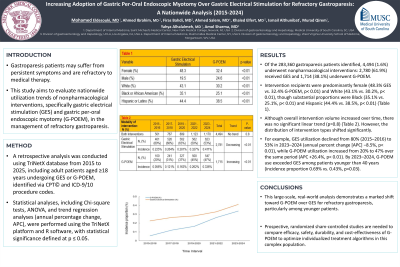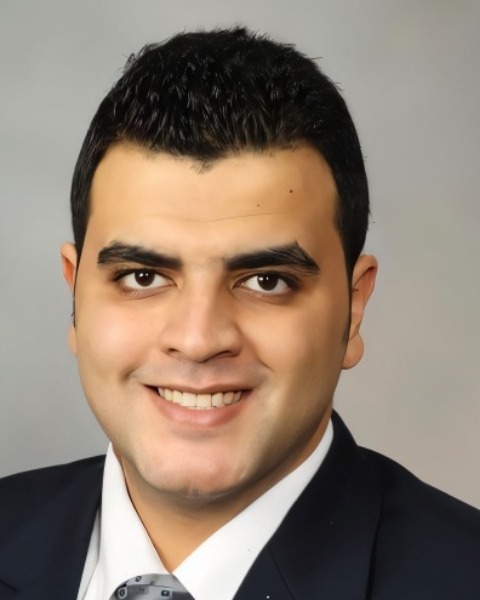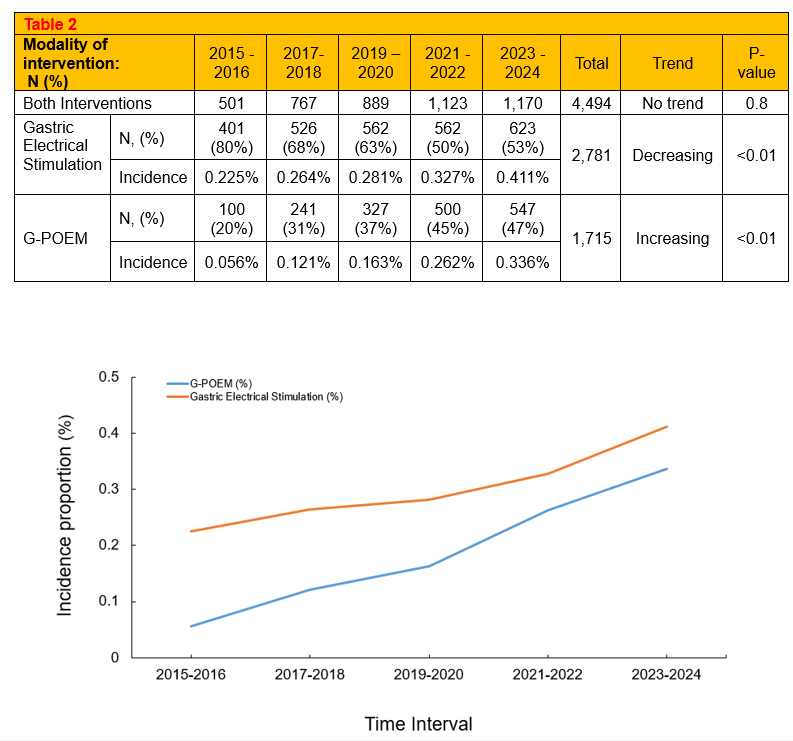Sunday Poster Session
Category: Stomach and Spleen
P2038 - Increasing Adoption of Gastric Per-Oral Endoscopic Myotomy Over Gastric Electrical Stimulation for Refractory Gastroparesis: A Nationwide Analysis (2015-2024)
Sunday, October 26, 2025
3:30 PM - 7:00 PM PDT
Location: Exhibit Hall


Mohamed Eldesouki, MD
Saint Michael's Medical Center, New York Medical College
Newark, NJ
Presenting Author(s)
Mohamed Eldesouki, MD1, Ahmed Ibrahim, MD2, Firas Bahdi, MD3, Ahmed Salem, MD4, Khaled Elfert, MBChB, MRCP5, Ismail Althunibat, MD6, Murad Qirem, MD7, Yahya Alhalalmeh, MD6, Amol Sharma, MD, MSc, FACG2
1Saint Michael's Medical Center, New York Medical College, Newark, NJ; 2Medical University of South Carolina, Charleston, SC; 3David Geffen School of Medicine at UCLA, Los Angeles, CA; 4Maimonides Medical Center, Brooklyn, NY; 5West Virginia University School of Medicine, Morgantown, WV; 6New York Medical College - Saint Michael's Medical Center, Newark, NJ; 7New York Medical College - Saint Michael's Medical Center, West Orange, NJ
Introduction: Gastroparesis (Gp) patients often suffer from persistent symptoms and are refractory to medical therapy. This study aims to evaluate nationwide utilization trends of nonpharmacological interventions, specifically gastric electrical stimulation (GES) and gastric per-oral endoscopic myotomy (G-POEM), in the management of refractory Gp.
Methods: A retrospective analysis was conducted using the TriNetX database from 2015 to 2025, including adult patients aged ≥18 years undergoing GES or G-POEM, identified via CPT© and ICD-9/10 procedure codes. Statistical analyses, including Chi-square tests, ANOVA, and trend regression analyses (annual percentage change, APC), were performed using the TriNetX platform and R software, with statistical significance defined at p ≤ 0.05.
Results: Of the 283,360 Gp patients identified, 4,494 (1.6%) underwent nonpharmacological interventions: 2,780 (61.9%) received GES and 1,714 (38.1%) underwent G-POEM. Intervention recipients were predominantly female (48.3% GES vs. 32.4% G-POEM, p< 0.01) and White (43.1% vs. 30.2%, p< 0.01), though substantial proportions were Black (35.1% vs. 25.1%, p< 0.01) and Hispanic (44.4% vs. 38.5%, p< 0.01) (Table 1). Although overall intervention volume increased over time, there was no significant linear trend (p=0.8) (Table 2). However, the distribution of intervention types shifted significantly. For example, GES utilization declined from 80% (2015–2016) to 53% in 2023–2024 (annual percent change [APC] −8.5%, p< 0.01), while G-POEM utilization increased from 20% to 47% over the same period (APC +26.4%, p< 0.01). By 2023–2024, G-POEM use exceeded GES among patients younger than 40 years (incidence proportion 0.69% vs. 0.43%, p=0.03).
Discussion: This large-scale, real-world analysis demonstrates a marked shift toward G-POEM over GES for refractory gastroparesis, particularly among younger patients. Prospective, randomized sham-controlled studies are needed to compare efficacy, safety, durability, and cost-effectiveness of G-POEM to optimize individualized treatment algorithms in this complex population.


Disclosures:
Mohamed Eldesouki, MD1, Ahmed Ibrahim, MD2, Firas Bahdi, MD3, Ahmed Salem, MD4, Khaled Elfert, MBChB, MRCP5, Ismail Althunibat, MD6, Murad Qirem, MD7, Yahya Alhalalmeh, MD6, Amol Sharma, MD, MSc, FACG2. P2038 - Increasing Adoption of Gastric Per-Oral Endoscopic Myotomy Over Gastric Electrical Stimulation for Refractory Gastroparesis: A Nationwide Analysis (2015-2024), ACG 2025 Annual Scientific Meeting Abstracts. Phoenix, AZ: American College of Gastroenterology.
1Saint Michael's Medical Center, New York Medical College, Newark, NJ; 2Medical University of South Carolina, Charleston, SC; 3David Geffen School of Medicine at UCLA, Los Angeles, CA; 4Maimonides Medical Center, Brooklyn, NY; 5West Virginia University School of Medicine, Morgantown, WV; 6New York Medical College - Saint Michael's Medical Center, Newark, NJ; 7New York Medical College - Saint Michael's Medical Center, West Orange, NJ
Introduction: Gastroparesis (Gp) patients often suffer from persistent symptoms and are refractory to medical therapy. This study aims to evaluate nationwide utilization trends of nonpharmacological interventions, specifically gastric electrical stimulation (GES) and gastric per-oral endoscopic myotomy (G-POEM), in the management of refractory Gp.
Methods: A retrospective analysis was conducted using the TriNetX database from 2015 to 2025, including adult patients aged ≥18 years undergoing GES or G-POEM, identified via CPT© and ICD-9/10 procedure codes. Statistical analyses, including Chi-square tests, ANOVA, and trend regression analyses (annual percentage change, APC), were performed using the TriNetX platform and R software, with statistical significance defined at p ≤ 0.05.
Results: Of the 283,360 Gp patients identified, 4,494 (1.6%) underwent nonpharmacological interventions: 2,780 (61.9%) received GES and 1,714 (38.1%) underwent G-POEM. Intervention recipients were predominantly female (48.3% GES vs. 32.4% G-POEM, p< 0.01) and White (43.1% vs. 30.2%, p< 0.01), though substantial proportions were Black (35.1% vs. 25.1%, p< 0.01) and Hispanic (44.4% vs. 38.5%, p< 0.01) (Table 1). Although overall intervention volume increased over time, there was no significant linear trend (p=0.8) (Table 2). However, the distribution of intervention types shifted significantly. For example, GES utilization declined from 80% (2015–2016) to 53% in 2023–2024 (annual percent change [APC] −8.5%, p< 0.01), while G-POEM utilization increased from 20% to 47% over the same period (APC +26.4%, p< 0.01). By 2023–2024, G-POEM use exceeded GES among patients younger than 40 years (incidence proportion 0.69% vs. 0.43%, p=0.03).
Discussion: This large-scale, real-world analysis demonstrates a marked shift toward G-POEM over GES for refractory gastroparesis, particularly among younger patients. Prospective, randomized sham-controlled studies are needed to compare efficacy, safety, durability, and cost-effectiveness of G-POEM to optimize individualized treatment algorithms in this complex population.

Figure: Gender and Racial distribution of the patients who underwent gastric electrical stimulation and G-PEOM from 2015 to 2024

Figure: Incidence of gastroparesis patients requiring gastric electrical stimulation, and G-POEM from 2015–2025.
Disclosures:
Mohamed Eldesouki indicated no relevant financial relationships.
Ahmed Ibrahim indicated no relevant financial relationships.
Firas Bahdi indicated no relevant financial relationships.
Ahmed Salem indicated no relevant financial relationships.
Khaled Elfert indicated no relevant financial relationships.
Ismail Althunibat indicated no relevant financial relationships.
Murad Qirem indicated no relevant financial relationships.
Yahya Alhalalmeh indicated no relevant financial relationships.
Amol Sharma indicated no relevant financial relationships.
Mohamed Eldesouki, MD1, Ahmed Ibrahim, MD2, Firas Bahdi, MD3, Ahmed Salem, MD4, Khaled Elfert, MBChB, MRCP5, Ismail Althunibat, MD6, Murad Qirem, MD7, Yahya Alhalalmeh, MD6, Amol Sharma, MD, MSc, FACG2. P2038 - Increasing Adoption of Gastric Per-Oral Endoscopic Myotomy Over Gastric Electrical Stimulation for Refractory Gastroparesis: A Nationwide Analysis (2015-2024), ACG 2025 Annual Scientific Meeting Abstracts. Phoenix, AZ: American College of Gastroenterology.
